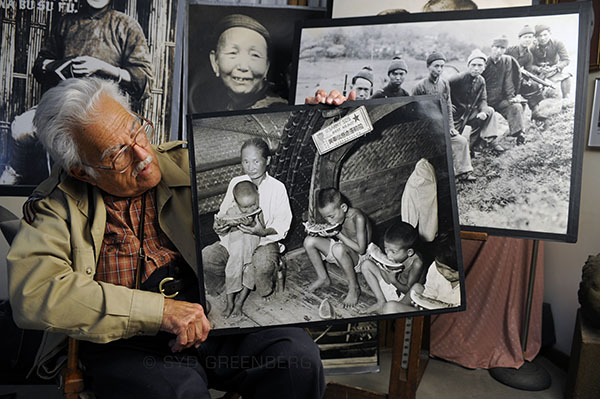Cameras and carbines capture life during wartime
By Zhao Xu (China Daily) Updated: 2015-07-30 07:57
|
Sydney Greenberg, a veteran of the US army's 164th Signal Photo Company, with some of the photos he took in China during World War II. Photo Provided to China Daily |
During World War II, a team of US army photographers spent two years recording the everyday lives and struggles of people living in and around the China-Burma-India Theater, which saw some of the fiercest action of the war in the Pacific. Zhao Xu reports.
Editor's Note: This is the seventh in a series of special reports about the experiences of foreigners who either lived or served in China between 1937 and 1945.
US army veteran Sydney Greenberg slept with "a light in the hallway and a flashlight by his bed all the time", according to his son, Philip.
The old soldier died in January 2012, 67 years after returning from the China-Burma-India Theater, one of the toughest, but least-reported, battlegrounds of World War II, where he roamed the countryside carrying a carbine in one hand and a camera in the other.
"My father was a member of the US army's 164th Signal Photo Company, assigned to the CBI to record the war in images," Philip Greenberg wrote in an e-mail exchange with China Daily. "There was one night in China when the Japanese snuck into the camp while the soldiers slept - my dad and his captain were near the center of the camp in hammocks with Chinese soldiers all around them. When dad woke up, he found that most of the men around him had had their throats cut. It seems the Japanese had worked their way from the fringes of the camp towards the center, killing off the soldiers closest to them. From that moment until the end of his life, dad was never able to shake off his fear of the dark," he said.
Very little of that darkness haunts the thousands of photos Sydney Greenberg took during a two-year stay in China's southwestern border region. Instead, his portfolio is tinged with warmth, and includes idyllic landscapes where the presence of war is only suggested by a rear view of a soldier. In one photo, a cameraman films Chinese children with a motion-picture camera, a device that had evidently captured the boys' imagination.
"Most of my dad's images show how the Chinese had tried to stabilize life a little bit within a war zone, and how they dealt with everyday life as it appeared in front of them. He photographed the people around him who were part of his life and part of the war," Philip Greenberg said.





